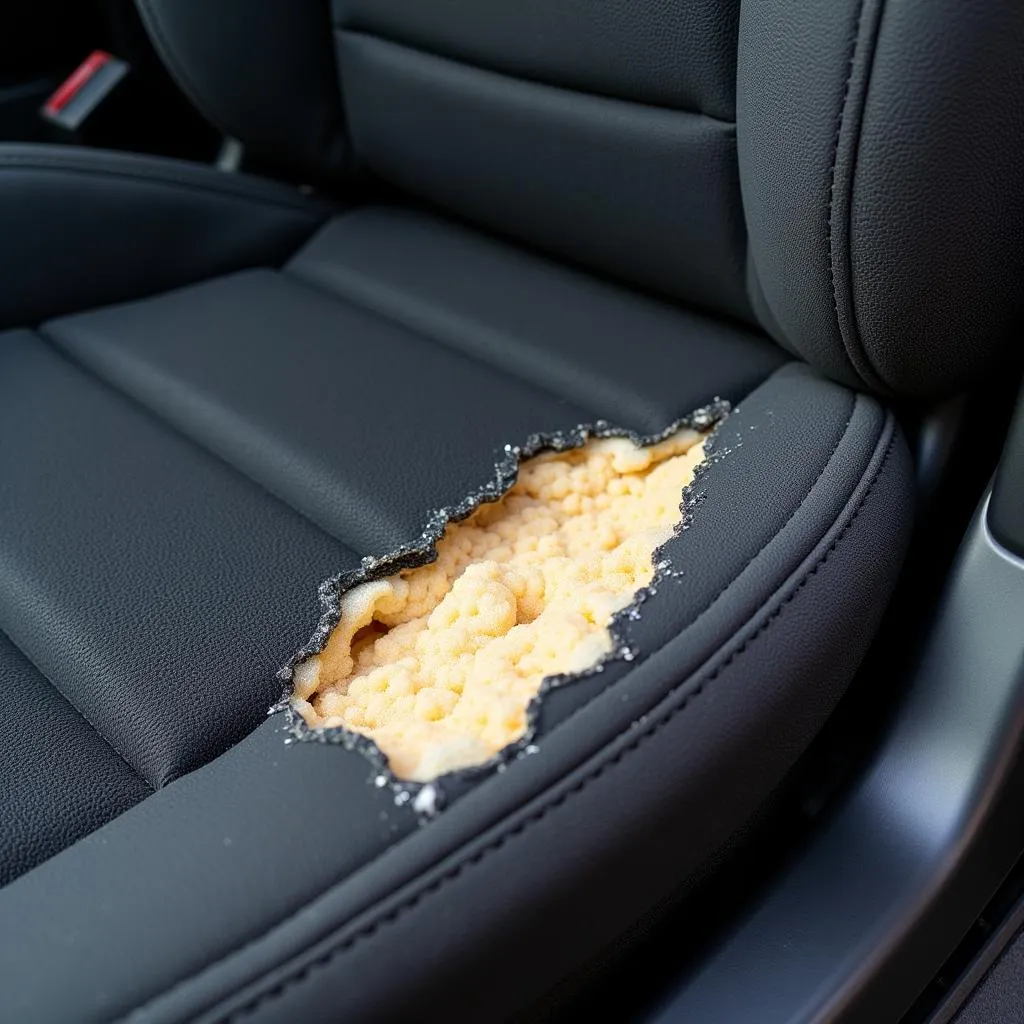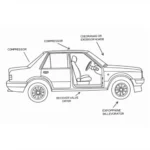Leather car seats lend an air of luxury and sophistication to any vehicle. But what happens when that pristine leather gets ripped, torn, or damaged? You’re probably wondering, “How much is this going to cost me?” Don’t panic just yet. This guide will walk you through the factors affecting leather car seat repair costs, the different repair options available, and how to keep your seats looking their best.
Understanding the Cost of Leather Car Seat Repair
The price tag on your leather car seat repair can vary significantly. Several factors come into play:
- Severity of the Damage: A small scratch is far less costly to fix than a large tear or a deep burn.
- Type of Repair Needed: Simple fixes like patching or stitching are cheaper than complex procedures like panel replacement.
- Quality of Materials: Premium leather repair kits and high-grade leather for replacements will cost more.
- Location and Shop Reputation: Expect to pay a premium at reputable auto upholstery shops in urban areas.
- Car Make and Model: Luxury vehicles often come with higher-grade (and pricier) leather, impacting repair costs.
Common Leather Car Seat Damage and Repair Costs
To give you a ballpark figure, let’s break down common repair types and their average costs:
- Surface Scratches and Scuffs: These minor blemishes can often be addressed with DIY leather repair kits or by a professional for around $50 to $150.
- Tears and Cuts: Depending on the size and location, repairs can range from $100 for a small tear to $500 or more for larger, complex tears.
- Burn Holes and Cigarette Burns: Repairing burn damage typically involves patching or replacing a section of leather and can cost between $150 and $400.
- Fading and Discoloration: Restoring faded leather requires specialized cleaning and dyeing techniques, usually costing $200 to $500 per seat.
- Full Seat Panel Replacement: In cases of extensive damage, replacing the entire leather panel might be necessary, costing upwards of $800 to $1500 per seat.
 Image of a ripped leather car seat
Image of a ripped leather car seat
DIY vs. Professional Leather Car Seat Repair
Faced with a ripped leather car seat, you have two primary options: roll up your sleeves and attempt a DIY fix or entrust your car’s interior to a professional.
DIY Leather Repair Kits:
- Pros: Affordable, readily available, and suitable for minor damage like scratches and small tears.
- Cons: May not provide a lasting solution for severe damage, and improper application can worsen the problem.
Professional Leather Repair Services:
- Pros: Expertise in handling various types of damage, access to quality materials, and ability to deliver a seamless, long-lasting repair.
- Cons: Significantly more expensive than DIY kits, requiring time for the shop to complete the repairs.
How to repair hole in leather car seats can be a great option for minor damages.
Factors to Consider When Choosing a Repair Option
Making the right choice depends on your budget, the extent of the damage, and your confidence in tackling a DIY project.
Ask yourself these questions:
- How severe is the damage? Minor imperfections might be manageable with a DIY kit, while major damage requires a professional touch.
- What’s my budget? If cost is a major concern, start with a DIY kit for minor issues.
- How much time am I willing to invest? DIY repairs require time, patience, and attention to detail.
Preventing Future Damage to Your Leather Car Seats
Prevention is always better (and cheaper) than a cure. Here are some tips to keep your leather seats looking their best:
- Regular Cleaning: Wipe down your seats weekly with a soft, damp cloth.
- Leather Conditioner: Use a dedicated leather conditioner every few months to prevent drying and cracking.
- UV Protection: Park in the shade or use a sunshade to protect your seats from harmful UV rays.
- Avoid Sharp Objects: Be mindful of what you bring into your car, as sharp objects can easily scratch or puncture leather.
Can a VW Golf collapsed leather car seat be repaired offers insightful information on specific car model concerns.
Conclusion
Ripped leather car seats don’t have to mean saying goodbye to your car’s luxurious interior. By understanding the factors that influence repair costs and exploring your DIY and professional options, you can make an informed decision to restore your seats to their former glory. And remember, regular maintenance is key to preventing future damage and keeping your leather looking its best for years to come.
FAQs
- Can I use any leather repair kit on my car seats?
It’s essential to choose a kit specifically designed for automotive leather to ensure compatibility and avoid discoloration. - Is it worth getting a professional repair for a small scratch?
While a DIY kit can address minor scratches, a professional can deliver a near-invisible repair, especially if color-matching is required. - How long does it take to repair ripped leather car seats?
The repair time depends on the severity of the damage. Minor repairs might take a few hours, while extensive damage could require a day or two.
How do u repair a hole in car seat is another helpful resource that provides step-by-step instructions for a DIY approach.
If you have any more questions or need professional assistance with your ripped leather car seats, don’t hesitate to contact our expert team via WhatsApp: +1(641)206-8880 or email us at [email protected]. We’re available 24/7 to help you restore your car’s interior to its prime condition.


